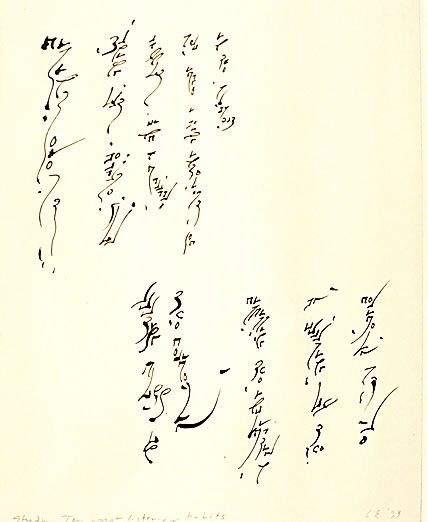The Elian Script is the creation C. C. Elian. It began as code by which Claudine could, at a glance, differentiate writings in her notebooks that were still in finished form from those still in the works. Over time it has developed into a form of calligraphy.
The structure of the Elian Script consists of the placement of the
26 Latin letters in alphabetical order within a 9-square grid as indicated below:

Each quadrant of the grid is unique in its compositional coordinates,
and except for box 9, contains three letters. For example, the quadrant
with a floor and a right wall ( ![]() )
can only be box 3; with a ceiling and a right wall
(
)
can only be box 3; with a ceiling and a right wall
( ![]() ) it can only be box 1.
) it can only be box 1.
By considering a specific box and its contents, we are now considering only three possible letters. To differentiate between these three letters we can agree to keep the box's structural lines equal in length to designate the first letter in alphabetical order.
![]()
Then, by making the structural lines of the box unequal to each other in length, we can designate the second letter in alphabetical order.

Finally, we can designate the third letter, in alphabetical order, to appear in a given box by agreeing to make its structural lines unequal in length and by accompanying it with a mark (dot, dash, anything that in itself is not a full line).

For the center box (E, N, W), the main concept is that of enclosed space rather than a specifically a square:

This three-level process then applies to all of the boxes and their respective letters. In addition to these structural parameters there are three compositional principles:
The consistent letter-to-box association and the application of the three principles is the essential structure of this writing system. The overall configuration and style is determined by exercising variables of (among others): line technique, writing instrument, line ratios, and left to right/top to bottom directional changes.
Here is an example of the entire alphabet in one of the many possible fluid forms:


This description is the abbreviated version of the Elian Script's structure; for further details see: http://www.ccelian.com/concepca.html
Constructed scripts for: Ainu | Arabic | Chinese languages | Dutch | English | Hawaiian | Hungarian | Japanese | Korean | Lingala | Malay & Indonesian | Persian | Tagalog / Filipino | Russian | Sanskrit | Spanish | Taino | Turkish | Vietnamese | Welsh | Other natural languages | Colour-based scripts | Tactile scripts | Phonetic/universal scripts | Constructed scripts for constructed languages | Adaptations of existing alphabets | Fictional alphabets | Magical alphabets | A-Z index | How to submit a constructed script
[top]
You can support this site by Buying Me A Coffee, and if you like what you see on this page, you can use the buttons below to share it with people you know.

If you like this site and find it useful, you can support it by making a donation via PayPal or Patreon, or by contributing in other ways. Omniglot is how I make my living.
Note: all links on this site to Amazon.com, Amazon.co.uk
and Amazon.fr
are affiliate links. This means I earn a commission if you click on any of them and buy something. So by clicking on these links you can help to support this site.
[top]